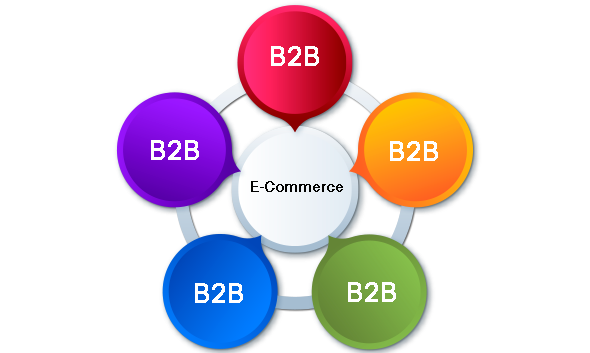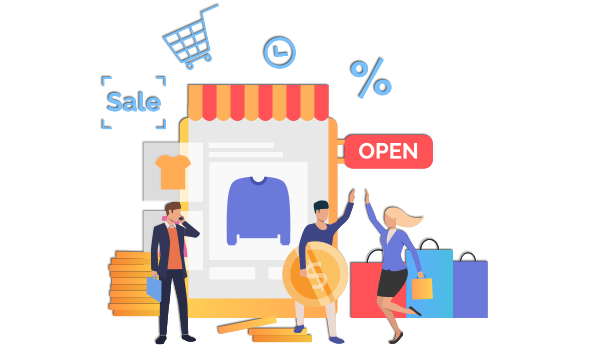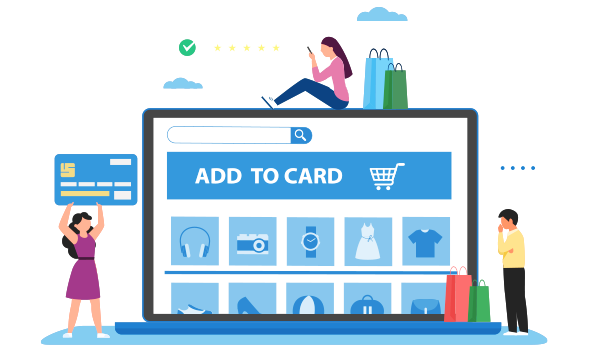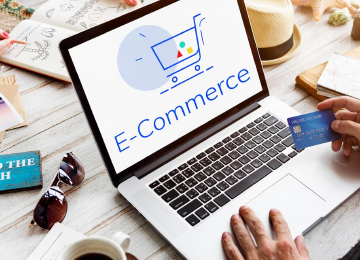
History of E-Commerce
E-commerce, born from 1960s EDI, bloomed in the 1990s with Amazon and eBay. PayPal's 1998 arrival eased payment concerns. Dot-com turbulence ensued, but giants like Amazon thrived.
The 2007 iPhone launch sparked mobile commerce. By 2015, mobile exceeded desktop use. Social commerce emerged, blending shopping with social media. AI's entry brought personalization and efficiency.
Today, e-commerce stands at the brink of innovation with AR, VR, and blockchain. From EDI to AI, it's a transformative adventure, promising an ever-evolving digital shopping experience.

Categories of E-Commerce
E-commerce is broadly categorised into five types:
- Business to Business (B2B)
- Business to Consumer (B2C)
- Business to Government (B2G)
- Consumer to Business (C2B)
- Consumer to Consumer (C2C)

Forms of E-Commerce
E-commerce takes various forms, including online retailing, electronic markets, and online auctions. It involves activities like online shopping, conversational commerce via chat and voice assistants, participation in online marketplaces, and business-to-business transactions.

Contemporary E-Commerce
Modern e-commerce can be classified based on the types of goods sold and the nature of participants. It has become a crucial tool for businesses globally, contributing to the growth of small and large enterprises. Cross-border e-commerce, facilitated by globalization, has opened new markets and business opportunities.
Governmental Regulation
Governments regulate e-commerce activities to ensure fair practices. In the United States, the Federal Trade Commission oversees commercial emails, online advertising, and consumer privacy. Various countries worldwide have adopted the UNCITRAL Model Law on Electronic Commerce for uniformity in e-commerce law.

Global Trends
E-commerce sales surpassed $1 trillion in 2012 and continue to grow. Mobile commerce, or m-commerce, plays an increasing role, with estimates suggesting it could constitute a quarter of the market. Traditional businesses are leveraging information technology and cross-border e-commerce for rapid development.
Logistics in E-Commerce
Logistics in e-commerce is crucial for order fulfilment. While larger companies often use fulfilment services, smaller businesses manage their logistic operations. Optimization of logistics processes is essential for prioritizing customer satisfaction.

Impacts of E-Commerce
- On Markets and Retailers:E-commerce is growing at a noticeable rate, impacting traditional retailers. Online markets are expected to grow significantly compared to traditional markets.
- On Supply Chain Management: E-commerce integrates inter-company and intra-company functions, optimizing physical, financial, and information flows in the supply chain.
- On Employment: E-commerce creates job opportunities but also leads to job losses in sectors like retail, postal, and travel agencies.
- On Customers: E-commerce provides convenience, a wider range of products, and the power to compare prices. However, concerns about security and product quality persist.
- On the Environment: The packaging and movement of goods in e-commerce contribute to environmental impact, raising concerns about recycling and accelerated movement of living things.
- On Traditional Retail: E-commerce's rise has led to the so-called "retail apocalypse," challenging traditional retailers and forcing them to adapt their strategies.

E-Commerce during COVID-19
The COVID-19 pandemic accelerated e-commerce growth, with online sales increasing significantly. Many consumers embraced online shopping during lockdowns, leading to a lasting impact on e-commerce sales.
Business Applications of E-Commerce
Common applications of e-commerce include business-to-business (B2B) and business-to-consumer (B2C) transactions, conversational commerce, digital wallets, and online banking.
Conclusion
The history and evolution of e-commerce have transformed the way businesses operate. From its early days to the current global trends, e-commerce impacts markets, supply chains, employment, and traditional retail. The COVID-19 pandemic further emphasized the importance of e-commerce. Whether you're a small business or a large enterprise, considering e-commerce is vital for reaching a broader audience and staying competitive in the modern marketplace.
